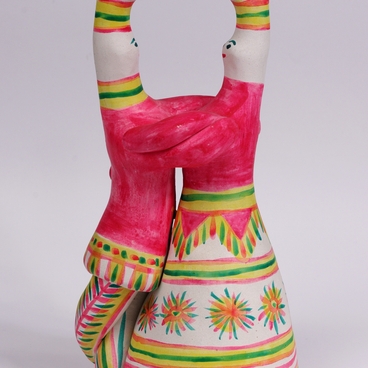Bright patterns of the Dymkovo toys are considered a symbol of the Vyatka land for a good reason. Dymkovo craftsmen richly decorated their works: there, one can find elegant ladies in crinoline dresses, ladies wearing pelerines and carrying umbrellas, gentlemen in top hats, as well as goats in suits with wide flounces. The toy from the museum’s collection is very characteristic of the craft and is called “Circus Goat”. It was created by a craftswoman Natalia Nikulina in the 20th century.
As a rule, the Dymkovo clay toy was sculpted piece by piece. The craftswomen molded the necessary shape from clay pancake-shaped lumps. To make animals, small legs were attached to a cylindrical body, and a head with an elongated snout was connected to a neck. The separate parts were created and sculptured individually using liquid clay as a binder. The craftsmen used a wet cloth to smooth the surface of a toy.
Red clay for the figurines was collected in the Dymkovo settlement on the low bank of the Vyatka River near the city of Kirov. Years ago, the raw material used to be chopped up with a shovel and mixed with fine river sand. After mixing, the clay was turned many times and moistened with water. In the olden days, people even trampled the clay with their feet. Nowadays, this energy-consuming process is no longer used. All preparation is done by machine at one of the ceramic factories. Clay comes to workshops in a ready-made condition — in briquettes of 10 kilograms each.
According to the tradition, after firing, the toys are primed white and painted with bright colors. The ornament was made with a wooden stick wrapped in linen cloth. Such an instrument was helpful only with the simplest patterns like lines, diamonds, circles, and zigzags. Nowadays, the craftsmen use brushes made of ferret or Siberian weasel fur.
In olden times, even the composition of paints was different: dry paints were ground with eggs, adding vinegar or excessively sour kvass (mildly alcoholic drink made from fermented rye bread, yeast, or berries). In the 20th century, the masters started painting figurines with gouache diluted with eggs. Nowadays the craftsmen prefer to use durable acrylic paints.
Interestingly enough, the circus theme appeared in Dymkovo not long ago. It was first introduced by the craftswoman Elizaveta Penkina in the 1930s. Having mastered the basic professional techniques, she started creating her own images. The craftswoman got the ideas from her own life experience and childhood memories. Natalia Nikulina further developed Elizaveta Penkina’s circus theme.
Unfortunately, there is too little information about Natalia Nikulina’s life. According to some sources, the 1980s — 1990s were her most active working period. It is also known that she taught one of the famous craftswomen — Elizaveta Koshkina.
As a rule, the Dymkovo clay toy was sculpted piece by piece. The craftswomen molded the necessary shape from clay pancake-shaped lumps. To make animals, small legs were attached to a cylindrical body, and a head with an elongated snout was connected to a neck. The separate parts were created and sculptured individually using liquid clay as a binder. The craftsmen used a wet cloth to smooth the surface of a toy.
Red clay for the figurines was collected in the Dymkovo settlement on the low bank of the Vyatka River near the city of Kirov. Years ago, the raw material used to be chopped up with a shovel and mixed with fine river sand. After mixing, the clay was turned many times and moistened with water. In the olden days, people even trampled the clay with their feet. Nowadays, this energy-consuming process is no longer used. All preparation is done by machine at one of the ceramic factories. Clay comes to workshops in a ready-made condition — in briquettes of 10 kilograms each.
According to the tradition, after firing, the toys are primed white and painted with bright colors. The ornament was made with a wooden stick wrapped in linen cloth. Such an instrument was helpful only with the simplest patterns like lines, diamonds, circles, and zigzags. Nowadays, the craftsmen use brushes made of ferret or Siberian weasel fur.
In olden times, even the composition of paints was different: dry paints were ground with eggs, adding vinegar or excessively sour kvass (mildly alcoholic drink made from fermented rye bread, yeast, or berries). In the 20th century, the masters started painting figurines with gouache diluted with eggs. Nowadays the craftsmen prefer to use durable acrylic paints.
Interestingly enough, the circus theme appeared in Dymkovo not long ago. It was first introduced by the craftswoman Elizaveta Penkina in the 1930s. Having mastered the basic professional techniques, she started creating her own images. The craftswoman got the ideas from her own life experience and childhood memories. Natalia Nikulina further developed Elizaveta Penkina’s circus theme.
Unfortunately, there is too little information about Natalia Nikulina’s life. According to some sources, the 1980s — 1990s were her most active working period. It is also known that she taught one of the famous craftswomen — Elizaveta Koshkina.

